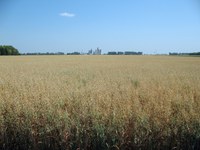Reduce Risk of Nitrates in Oat Hay
(Click the image below to view a high-resolution image that can be downloaded)
High levels of nitrate in feed can be toxic to cattle, a North Dakota State University Extension livestock expert warns.
Nitrate interferes with the oxygen-carrying capacity of the animals’ blood, which can result in abortions and sudden death.
“Oat hay is known as a feed prone to accumulate nitrates when grown under environmental stress,” says John Dhuyvetter, Extension livestock systems specialist at the North Central Research Extension Center near Minot, N.D. “It also responds well in growth and yield to nitrogen fertilizer, which contributes to elevated nitrates.”
Drought is an environmental stress that can cause oat hay to accumulate nitrate.
“With the droughty summer in central and western regions of the state, it is not surprising some cattlemen are finding nitrate levels in oat hay that are of concern,” Dhuyvetter says.
He recommends producers get oat hay tested for nitrate levels before feeding it to their livestock.
Producers should dilute oat hay with low-nitrate feeds to avoid health issues if tests show the oat hay has 1,500 to 3,500 parts per million (ppm) of nitrate nitrogen. For pregnant cows and heifers, nitrate levels below 1,000 ppm are considered safe. Feed with nitrate levels less than 1,500 ppm are considered safe for other classes of cattle.
“Oat hay testing 2,500 ppm of nitrate, if fed at only a fourth of the ration, would bring the ration to 625 ppm and well below the level for animal safety,” Dhuyvetter says. “However, it means all animals must eat an equal mix of feeds and no cow gets an opportunity to eat primarily the high-oat hay. Grinding and blending through a mixer helps ensure this is the case.”
He suggests that another way to reduce the likelihood of nitrate poisoning is to introduce very limited amounts of high-nitrate feeds, then slowly increase to an accepted limit. Feeding a small amount of an easily digested grain also can reduce nitrate absorption into the blood.
For more information, search online for the NDSU “Nitrate Poisoning of Livestock” publication.
NDSU Agriculture Communication - Dec. 19, 2018
| Source: | John Dhuyvetter, 701-857-7682, john.dhuyvetter@ndsu.edu |
|---|---|
| Editor: | Ellen Crawford, 701-231-5391, ellen.crawford@ndsu.edu |


